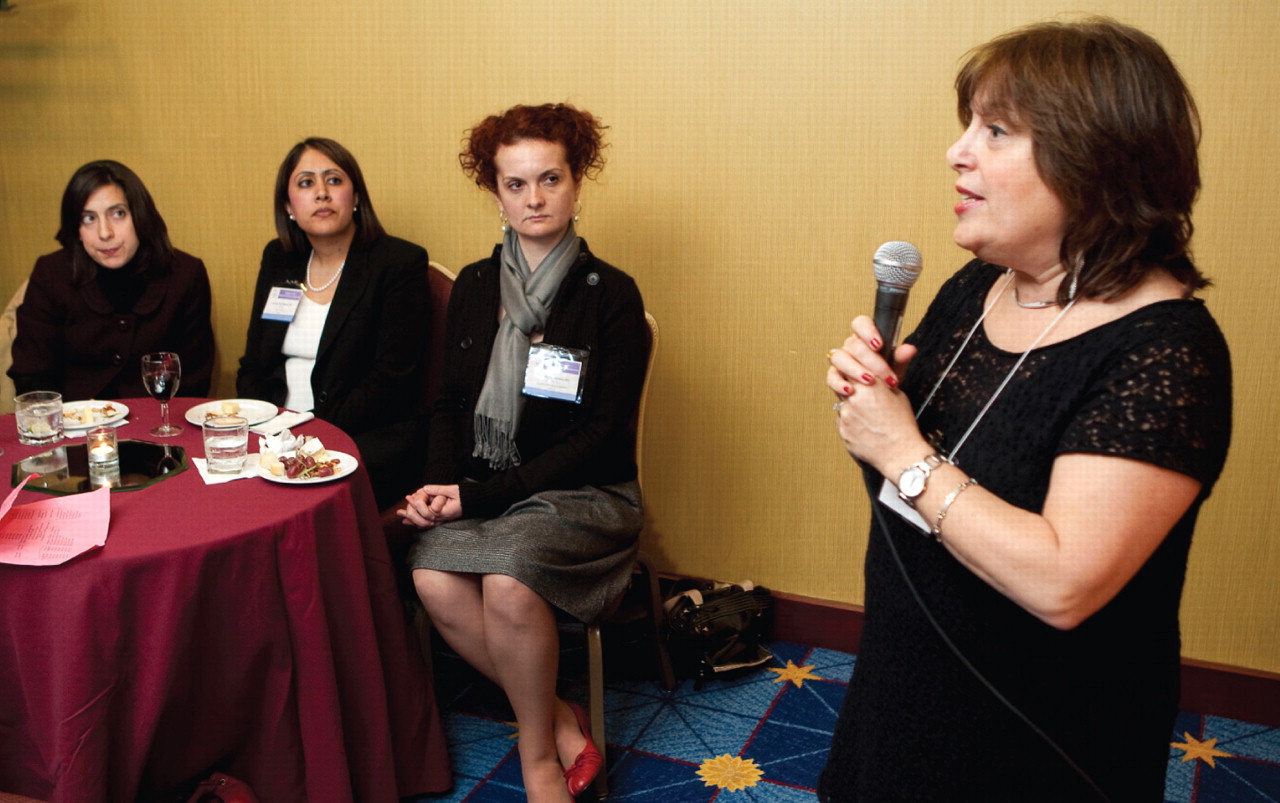Bernstein Invites Input From APA's Newest Members
Abstract
Caught between a growing number of new psychiatrists foregoing membership and fiscal resources that are rapidly shrinking, APA is aiming to rearrange existing assets to better address the needs of its youngest members.
As part of that effort APA President-elect Carol Bernstein, M.D., is taking a lead role in efforts to arrest the decline in recent years in the number of early career psychiatrists who continue as APA members after residency.
“Thirty years ago, everyone joined APA, but it's a different world now,” Bernstein said at a November town-hall meeting in conjunction with the APA Assembly meeting in Washington, D.C. About 30 medical students and new psychiatrists attended the session.

APA President-elect Carol Bernstein, M.D., exchanges ideas with medical students and new psychiatrists in November to address the increasing number of early career psychiatrists who drop their APA membership.
Recent membership data tell the story. Among the early career psychiatrists who had joined APA as medical students, 14 percent left in 2005, but these departures rose to 28 percent in 2008. And few of the early career psychiatrists who leave the Association rejoin later in their careers, she said.
“If we can't keep you, there will be no APA,” Bernstein told the gathering of young clinicians, the second such meeting she has held in as many months. Bernstein also met with 60 residents, fellows, and early career psychiatrists at an October town-hall meeting during APA's Institute on Psychiatric Services in New York (Psychiatric News, December 4).
Based on the responses Bernstein received from young clinicians in November, the disconnect with APA's lost members may stem from a combination of a perceived lack of local benefits for APA members and ignorance by members about benefits they receive from the Association's extensive national efforts in education and advocacy.
One local focus that's needed, said several of the physicians, is an increased use of mentorship programs for medical students and early career psychiatrists. In one suggested approach, APA could assign a mentor to every new member upon joining.
“It's been wonderful—the mentorship I've gotten over the years in terms of how it has helped me progress professionally,” Nita Dhaliwal, M.D., a Virginia psychiatrist told Psychiatric News in a later interview.
Some of the young clinicians said that they were hearing about mentorship programs offered by APA for the first time at the November meeting. Bernstein agreed that APA needs to better publicize its mentorship programs.
Bernstein also called on early career psychiatrists who are active in APA to undertake outreach to other young psychiatrists by hosting local gatherings at their homes and educating others about resources that APA offers, including training in the public-affairs and advocacy arenas.
“We have staff to do that, and they're not being utilized,” Bernstein said.
Ben Holt, M.D., for example, a third-year resident, has hosted dinners at his home in Missouri with other residents and medical students interested in APA to educate them about some of the benefits they could receive by joining.
“I was initially encouraged by another resident to become involved in APA,” Holt told Psychiatric News.
Bernstein, a former residency training director and now associate dean for graduate medical education at New York University, also encouraged APA's medical-student members to help raise the Association's profile at their medical schools by talking to residency training directors about the benefits of APA membership for their students.
Medical students often “don't even know what APA does,” she said.
For example, among the many benefits APA provides for all of psychiatry is its extensive federal advocacy that in recent years led to the enactment of a comprehensive federal insurance parity law and ongoing efforts to include mental health care coverage as a mandatory benefit under health care reform. APA also offers educational and lobbying assistance to psychiatrists in their state-specific legislative efforts.
The ongoing impact of the recession and a reorientation away from dependence on pharmaceutical funding have limited APA's ability to bring new resources to bear on the problem of membership departures by new psychiatrists. However, many of the meeting attendees urged Bernstein not to allow cost-cutting to exacerbate the member dropout problem.
Several young clinicians stressed that replacing some meetings with online or teleconference meetings could backfire, because the benefits of casual interactions at in-person events was a major reason that they remained in APA. Bernstein encouraged the young leaders in psychiatry to take the initiative and hold more local meetings with their colleagues.
One suggested option that Bernstein saw as highly unlikely in the face of APA's drastically reduced revenues was reducing membership dues that young psychiatrists pay. These members already pay substantially lower dues than do general members. She pointed out that APA needs the dues revenue to keep its many programs operating and its member benefits available. 



